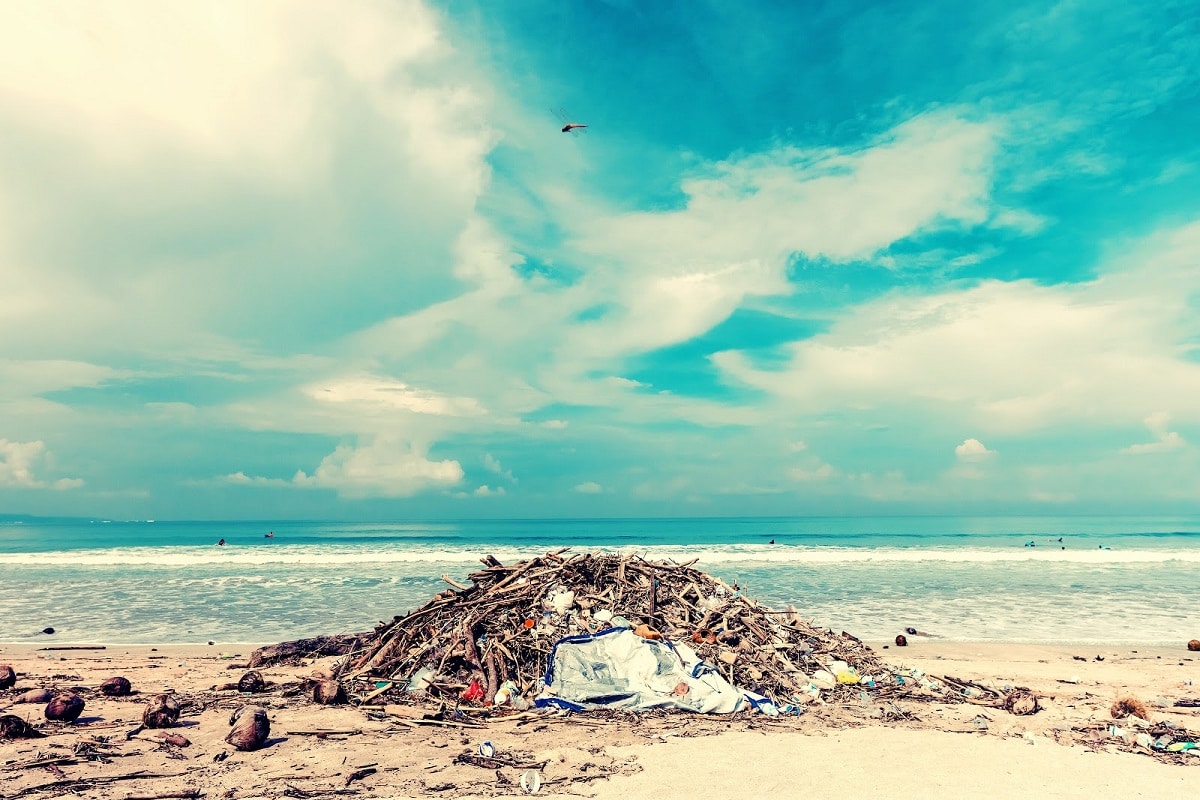Plastic is an integral part of the human experience and has become a foundational product in our daily lives. We use plastic for almost everything; it’s in our cars, we brush our teeth with it, 90% of our food comes wrapped in or surrounded by it. Plastic has taken over our planet and is now one of the most common substances on earth, whereas just under 100 years ago it didn’t even exist. Plastic is not a solution, it is a problem. Here are the top ten facts about plastic you wish you never knew, but need to read.
1. 100 Million Tons of Plastic is Manufactured Each Year
In the history of the world…8.3 billion tons of plastic have been manufactured over only 6 decades. As if this figure were not impressive enough, plastic production has only been taking place for about 70 years. That means as a species we create, and use, 1.2 Billion tons of plastic per decade on average. The creation of plastic waste began in the early 1950s when chemical engineers discovered that oil could be synthesized into a flexible but hard material. There are many different kinds of plastic, but the most commonly used plastics in modern society are Polyethylene Terephthalate, commonly referred to as PET, High-Density Polyethylene, Low-Density Polyethylene, and Polypropylene. These four types of plastic are used to make common plastic items you would find in your home, those that you would most frequently use in your day to day life. PET, is a polyester resin that when combined with other synthetic materials creates a thin, flexible, clear plastic, that is highly durable. This form of plastic is often used for soft drinks and water bottles. High-density polyethylene is generally used to manufacture plastic jugs for milk and juice and is also the primary type of plastic found in single-use plastic bags. HDPE, or High-Density Polyethylene, is a thicker, more rigid, and typically opaque plastic, and is more prone to deterioration at high temperatures. Low-Density Polyethylene (LDPE) is highly resistant to chemicals and acts as a natural oxygen barrier. With its unique ability to prevent gasses like oxygen to pass through its surface, this type of plastic is most commonly used for resealable plastic bags, plastic wrap, and garbage bags. Polypropylene is a high-durability, high-flexibility plastic, which can withstand extreme temperatures. This is considered to be the most environmentally unfriendly of all plastics as it is often used for those items which are most destructive to the environment like chip bags, plastic straws, and microwaveable plastic containers. These are just a few of the different types of plastic which contribute to the 8 billion tons manufactured within the last 70 years, but these four are especially harmful to the environment.
2. Only 9% of All Plastic Ever Made Has Been Recycled
To make matters worse, most plastic that is manufactured and used is not disposed of properly. Most plastic is not recycled, in fact, 91% of all plastic produced is made for one-time use and then disposed of. It would be the hope that this plastic would then be responsibly destroyed but unfortunately, only 12% of plastic ever made has been incinerated. This means that 88% of all plastic ever created still exists in some form! This equates to 7.3 billions tons of plastic that have been added to the earth without disposal or removal from the planet, and this number is increasing each year exponentially. To put this number in perspective, that means that for every one person on earth, there are 1600 pounds of plastic waste.
3. Plastic Kills Marine Life
Plastic waste is responsible for the death of over 1 million sea-based life forms each year, including, birds, fish, amphibians, and marine mammals. Polyethylene Terephthalate and Polypropylene, are the two culprits behind the leading cause of death in seabirds and marine life. Single-use plastic items like grocery bags and plastic straws have a severe environmental impact that’s killing wildlife at an alarming rate. Chip bags and plastic straws are often mistaken for food and as a result, are ingested and then cause suffocation. The small size, reflective shimmer, and colorful hue of plastic items like bags and straws act as an irresistible lure to birds, fish, and turtles. Straws especially have been recently tied to an epidemic of suffocation in turtles and are the most common form of plastic pollution in the ocean behind single-use bags and single-use bottled water. For many different marine species, plastic waste and the use of Polypropylene and PET is directly to blame.
4. Plastic Never Fully Degrades
Forget diamonds, plastic is the real champion when it comes to being the most durable material on earth. Plastic never fully degrades. This fact may take a moment to digest. How can it be that it is estimated that plastic takes, on average, 500 years to break down, and yet it never fully degrades? Due to the chemical composition of most plastics, the material degrades slowly over time and breaks apart into tiny pieces of plastic that are invisible to the human eye called microplastics. These microplastics are as dangerous to humans as large parts of plastic are to the earth. These microplastics contaminate sources of food and water and can do so without detection. In fact, in a given year, it is estimated that the average human eats upwards of 70,000 microplastics. To put this into perspective this comes out to around a credit card worth of plastic per week.
5. Plastic Waste is Causing Trash Islands to Form in Our Seas
Plastic waste is so prevalent, and so poorly cared for that it has literally created massive islands at sea which have come to be known as “trash islands” or “garbage patches.” There are five major garbage patches scattered amidst our world’s oceans, the largest of which is located halfway between California and Hawaii. Also known as the great Pacific garbage patch, it is the largest offshore accumulation site for trash and debris, most of which is made up of the four types of plastics listed above. Comprised of almost two million tons of plastic, this patch is the largest in the world and is comparable in size to the state of Texas. Additional trash islands can be found in the Indian Ocean, South Pacific, and two equally sized floating garbage patches are located in the North and South Atlantic. These floating colonies of debris collect when patterns in oceanic currents sweep plastic waste into one concentrated area where currents meet creating a vacuum that binds all of this trash together to form literal islands of waste. The garbage patches, aside from being horrendously off-putting, pose a real and severe threat to marine life like sea turtles mistaking it as a safe haven for shelter, food, and rest.
6. It Takes 450 Years For a Water Bottle to Disintegrate
Did you know it takes more water to make a single-use plastic water bottle than that bottle can even hold? The single-use plastic water bottle is one of the most commonly used plastic items on earth. It takes approximately 450 years for a water bottle, made of PET, to disintegrate. But remember, although lost, these particles are not really gone as they have simply turned into smaller microplastics. The worldwide total of plastic water bottles consumed each year is upwards of 500 billion, and the US alone is responsible for 50 billion plastic bottles per year. The best case scenario is that these water bottles end up in landfills where they can eventually be incinerated, but as we already know that most plastics never make it that far. Much more often, the final resting place of these water bottles is a fate that is detrimental to our world’s greatest asset, our oceans. Paying for a single use plastic water bottle is the same as throwing your money into the ocean, except your money would do far less damage. You would be much better off purchasing a reusable canteen, preferably not plastic, and a water purification system like FloWater. FloWater could save you hundreds of single-use water bottles per year which would, in turn, save you hundreds, if not thousands, of dollars, while simultaneously preventing further destruction to the planet. It’s a win-win.
7. Soon There Will be More Plastic in The Sea Than Fish
At the current rate of production and usage, it is estimated that by the year 2050, the total weight of plastic in the world’s oceans will be greater than the weight of every fish on earth. While this may seem unbelievable, consider for a moment that 45% of the world’s plastic waste ends up in the ocean and 90% of the debris in the sea is plastic! Plastic waste is a plague on the sea, a cancerous infection that is wreaking havoc and destroying one of the earth’s most incredible treasures. Also, consider the idea that most data regarding plastic in the world’s oceans is based on the debris that can be collected because it floats. At this point, there is no way for us to measure the amount of plastic that has filled with water and sunk to the deepest parts of the ocean bottom.
8. 8% of The World’s Oil is Used to Create a Year’s Worth of Plastic
Plastic is a derivative of oil, and it takes a lot of oil to make all the plastic we use. It is estimated that 8% of the world’s oil is used to create a year’s worth of plastic. Forget for a moment that oil is another one of earth’s limited commodities, oil is terrible for the environment! Think about how devastating an oil spill is on oceanic life. Now, remember that plastic is made from oil and 45% of the world’s plastic is strewn across the sea! There is quite literally an oil spill the likes of which we have never seen before plaguing our earth. Plastic not only harms the earth after it is disposed of, but it also contributes to increased emissions and a build-up of greenhouse gases because of the fossil fuels required for production.
9. The World Uses 500 Million Plastic Straws Per Day
Plastic is made for one-time use. 40% of the world’s plastic production is directly related to packing and shipping, which is often only used once and not recycled. In addition, the household products we use every day like plastic bags and straws end up in the garbage after only one use. Per day the world uses 500 million plastic straws, 300 million plastic bags, and 1.3 billion water bottles. The average amount of time a plastic bag is used before it is thrown away is only 12 minutes. When you compare these twelve minutes of use to the 400 years it will take for the bag to break down, the short time use hardly seems worth the long term cost.
10. More Plastic Was Produced Between 2009 and Present Than Was Used in The Entire Previous Century
The past ten years have seen a dramatic increase in the production and use of plastic materials. In fact, more plastic was produced between 2009 and the present than was used in the entire previous century. It is predicted that by 2050 the production and total amount of plastic debris on earth will increase by another 50%, putting the total weight of plastic waste on earth somewhere around 13 billion tons.
While it is devastating to read about all the adverse effects plastic is having on the planet, it is essential to empower humans with the facts so they understand the impact plastic is having on our earth and are motivated to make a change. It is time to end humanities short-lived dependence on plastic and return to a cleaner, healthier way of life. So how can you help?
The first thing you can do is to eliminate single-use plastics such as plastic water bottles and plastic straws from your day to day life. Considering the negative effects that plastic consumption has on your health, eliminating these should be a no-brainer. In fact, it is reported that over 90% of Americans over the age of 5 have some level of BPA poisoning. BPA is a toxic chemical secreted from plastic that we, in turn, ingest and can lead to serious health complications. The only way to avoid BPA contamination is to avoid plastic. Reducing plastic usage will help our planet and your health.
Another way you can help to eliminate single-use plastics is by implementing a filtered water dispenser like those made by FloWwater. Water filters such as these reduce the need for, and use of single-use plastic water bottles since they provide purified water on-demand. FloWwater’s water filtration system takes it even further with its 7x Advanced Purification system that eliminates up to 99.9% of impurities found in tap water. With FloWater, you can drink water that’s highly purified and more energy efficient without plastic waste. Plus, it’s more cost-effective and easily accessible for all.
Sources:
https://www.sas.org.uk/our-work/plastic-pollution/plastic-pollution-facts-figures/
https://www.earthday.org/2018/03/07/fact-sheet-end-plastic-pollution/
https://passportocean.com/2018/02/24/facts-plastics-oceans/
https://www.australianethical.com.au/news/10-plastic-pollution-facts/
https://list25.com/25-scary-facts-about-plastic-pollution-thatll-change-your-habits/




